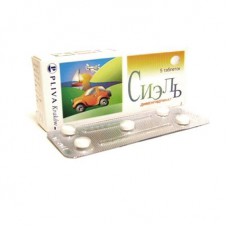Expiration date: 05/2026
The composition and form of issue:
Tablets. 1 tablet contains:
dimenhydrinate 50 mg
other ingredients: microcrystalline cellulose, silica colloidal anhydrous, magnesium stearate, talc
in packing contour cell 5 PCs. in cardboard pack 1 pack.
Description pharmaceutical form:
Tablets white color, smooth, round, lenticular, without spalled edges. On the surface of tablets is stamped with the letter "A".
Pharmacokinetics:
After ingestion the drug is well absorbed from the gastrointestinal tract, distributed to organs and tissues.
Dimenhydrinate biotransformation in the liver and is fully excreted by the kidneys within 24 h. T1/2 is about 3.5 h. a Small amount can be excreted in breast milk.
Description pharmacological action:
Has antiemetic effect. Also has sedative, antihistamine effect. Depresses the Central nervous system, weakens the Central anticholinergic consequence of vestibular stimulation.
Pharmacological effects associated with blockade of histamine H1-receptors and m-cholinergic receptors of the CNS. Antiemetic effect of dimenhydrinate is based on the blocking of the vomiting center in the medulla and parasimpaticheskim his action, which, in turn, leads to smooth muscle relaxation and inhibition of peristalsis of the digestive tract, inhibition of the function of the salivary glands and the inhibition of the vomiting center.
Reduces or eliminates the effect of endogenous histamine. Due to the blocking effect of the increased permeability of capillaries dimenhydrinate is effective for allergic reactions (urticaria, vascular edema).
The effect is manifested through 20-30 minutes and lasts for 4-6 hours .
Indications:
- sea and air sickness
- prevention and treatment of symptoms of vestibular and labyrinth disorders (dizziness, nausea, vomiting, except for symptoms caused by anticancer therapy)
- ménière's disease.
Contraindications:
- hypersensitivity to dimenhydrinate and other components of the drug
- bronchial asthma
- epilepsy
- pregnancy (I trimester)
- children up to age 2 years.
With caution:
- prostatic hyperplasia with clinical manifestations, urinary retention, bladder neck obstruction
- angle-closure glaucoma (including predisposition to it), otkratougolnaya glaucoma
- in patients with stenosing peptic ulcer
- in hyperthyroidism
- in diseases of the circulatory system.
Application of pregnancy and breast-feeding:
Contraindicated in the first trimester of pregnancy.
In II and III trimestrah possible if the expected effect therapy outweighs the potential risk to the fetus.
For the period of the drug feeding breast milk should be suspended.
Side effects:
Adverse reactions are usually minor and were in the employment of doses higher than specified in the instructions.
CNS and sensory organs: fatigue, weakness, drowsiness, loss of concentration occasionally, anxiety, depression, dizziness, headache, insomnia (especially in children), disturbance of accommodation, loss of night and color vision.
On the part of the digestive tract: may include nausea, vomiting, loss of appetite, diarrhea, dry mucous membranes in the mouth.
Allergic reactions: angioedema, urticaria, bronchospasm.
Other: in isolated cases, there may be a decrease in blood pressure, arrhythmia, dysuria.
Drug interactions:
Do effects of atropine, tricyclic antidepressants, catecholamines, barbiturates, alcohol, sedatives and hypnotics, neuroleptics.
Reduces the effect of corticosteroids, anticoagulants.
Simultaneous reception of the drug with theophylline leads to increased concentrations of theophylline.
Reduces depressive effect of acetylcholine on the heart muscle.
By a simultaneous intake of amphetamine and its derivatives acts as an antagonist.
Not appoint a drug with ototoxic antibiotics (streptomycin, neomycin, viomycin, kanamycin, amikacin).
Method of application and dose:
Inside.
For the prevention of sea and air sickness for 30 min before the planned trip: adults and children over 14 years old — 50-100 mg (1-2 table.) children from 7 to 14 years — 50 mg (1 table.) 2-6 years — 25-50 mg (½–1 tab.). If necessary reception can be repeated.
When the vestibular disorders — before meals: adults — 50-100 mg 2-3 times daily (daily dose should not exceed 400 mg) children 6-14 years — 25-50 mg 3 times daily (daily dose should not exceed 150 mg).
Overdose:
Symptoms: the first symptoms of overdose may occur after 0.5–2 h after administration of doses of 25-250 mg/kg and manifest mainly in the form of headaches, dizziness, drowsiness and fatigue. Subsequently, they may join the itching of the skin, vasodilation of the skin, dilated pupils and slow reaction of pupils to light, accommodation disturbance, nystagmus, decreased muscle tone and tendon reflexes, urinary retention, tachycardia, changes in AD. Then may experience symptoms of CNS depression: impaired speech, orientation in time and space, ataxia, coma, respiratory depression, possible agitation.
Children may experience hallucinations, convulsions, death.
Treatment: gastric lavage, administration of activated charcoal. If necessary, further treatment is conducted in inpatient appointment of symptomatic therapy.
Precautions:
Not to be administered in combination with cardiac glycosides, neuroleptics and alcohol.
Used with caution in conjunction with drugs having ototoxic effect (the drug may mask symptoms of hearing loss), bismuth preparations, analgesic and psychotropic drugs (concomitant use may lead to deterioration of vision).
During treatment should refrain from driving and from work, require increased attention.


